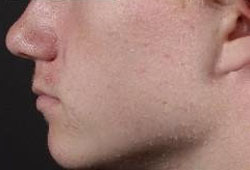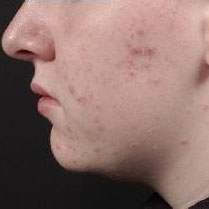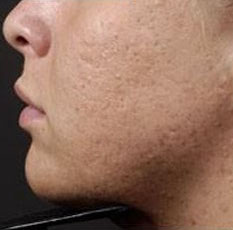Approach
Characteristic history and examination findings are usually sufficient to diagnose acne vulgaris.
Although many acne grading/classifying systems have been developed, no standardised approach exists for clinical practice. See Classification.
History
Acne vulgaris classically begins as puberty commences, but the clinical course is highly variable. Women may note a fluctuating course centred on their menstrual cycles.
Acne fulminans is a rare acne subtype that presents with variable systemic manifestations, including fever, arthralgias, myalgias, hepatosplenomegaly, and osteolytic bone lesions.
Certain drugs may induce acne, and a thorough drug history should be elicited. Patients should also be asked about signs and symptoms that might suggest an endocrine disorder such as polycystic ovary syndrome.[19]
Signs of psychological distress or a mental health disorder may be present due to the significant impact of acne on confidence and self-worth.[2][34]
Physical examination
Non-inflammatory acne manifests as whiteheads (closed comedones) and blackheads (open comedones). Inflammatory lesions begin as microcomedones but may develop into papules, pustules, nodules, or cysts. Both types of lesions are found in areas of dense sebaceous glands.
Acne may affect only the face, but the chest, back, and upper arms are often involved. Moderate-to-severe acne lesions may leave post-inflammatory hyperpigmentation and/or atrophic scars. Other individuals may form hypertrophic scars at areas of prior involvement.[35]
Severe nodulocystic acne presenting with fever, arthralgia, myalgia, hepatosplenomegaly, and osteolytic bone lesions suggests acne fulminans.[Figure caption and citation for the preceding image starts]: Comedonal acneUniversity of Michigan Department of Dermatology [Citation ends]. [Figure caption and citation for the preceding image starts]: Typical appearance of acneUniversity of Michigan Department of Dermatology [Citation ends].
[Figure caption and citation for the preceding image starts]: Typical appearance of acneUniversity of Michigan Department of Dermatology [Citation ends]. [Figure caption and citation for the preceding image starts]: Scarring acneUniversity of Michigan Department of Dermatology [Citation ends].
[Figure caption and citation for the preceding image starts]: Scarring acneUniversity of Michigan Department of Dermatology [Citation ends]. [Figure caption and citation for the preceding image starts]: Nodulocystic acneUniversity of Michigan Department of Dermatology [Citation ends].
[Figure caption and citation for the preceding image starts]: Nodulocystic acneUniversity of Michigan Department of Dermatology [Citation ends].
Laboratory evaluation
Routine endocrinological testing is not indicated for the majority of patients with acne.[36] In patients with acne and evidence of hyperandrogenism, hormonal evaluation for free testosterone, dehydroepiandrostenedione sulphate, luteinising hormone, 17-hydoxyprogesterone, and follicle stimulating hormone is warranted. See Polycystic ovary syndrome and Precocious puberty.
Routine microbiological testing is unnecessary in the evaluation and management of patients with acne.[36] If lesions centred in the peri-oral and nasal areas are unresponsive to conventional acne treatments, consider bacterial culture and sensitivities to evaluate for gram-negative folliculitis.
Use of this content is subject to our disclaimer